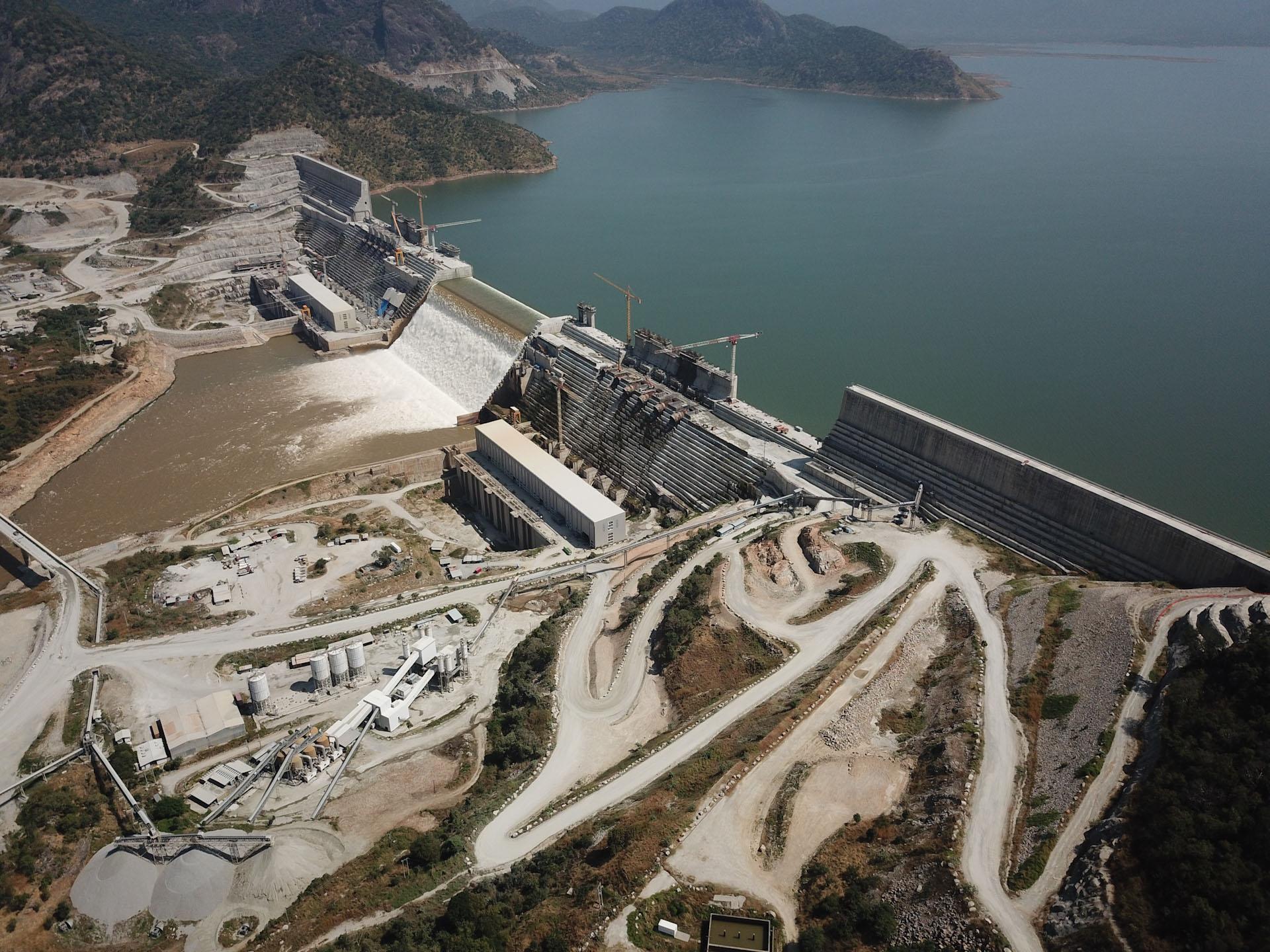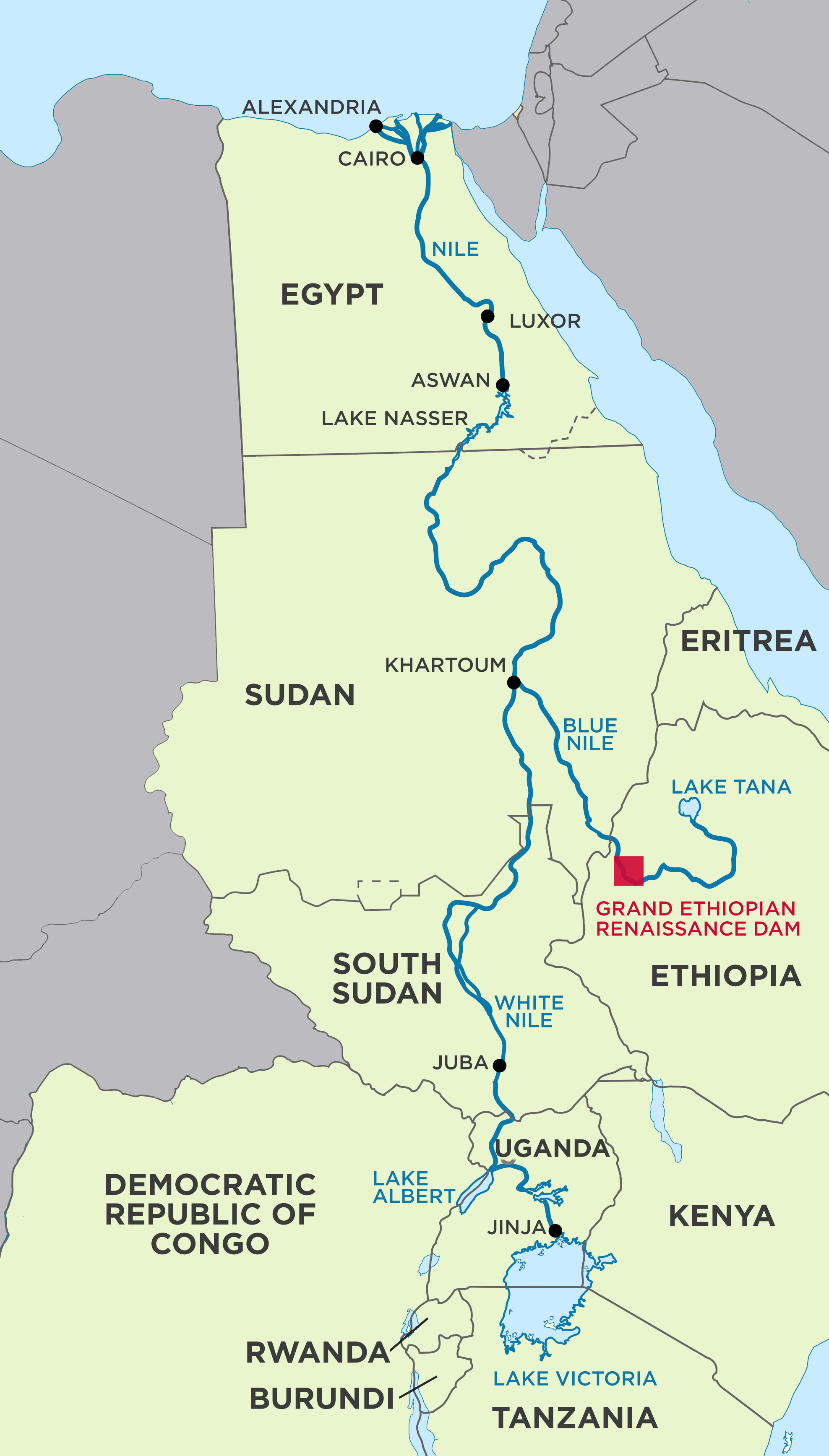Grand Ethiopian Renaissance Dam (GERD)
The Grand Ethiopian Renaissance Dam (GERD), formerly known as Millennium Dam and sometimes referred to as Hidese Dam, is a gravity dam situated on the Blue Nile River in the Benishangul-Gumuz Region of Ethiopia. The primary purpose of this dam is to generate electricity, addressing Ethiopia’s energy shortage and facilitating electricity exports to neighboring countries. The initial planned generation capacity of 5250 MW was later increased to 6450 MW with various adjustments made over time. Construction began in 2011 after the eventual site was identified in the 1950s. The main dam height has been raised to 155m, and the reservoir at Full Supply Level (FSL) covers an area of 1875km². Three spillways, with a combined total discharge volume of 38,500 m³/s, are designed for flood events.

Africa’s $5 Billion Mega-Dam
Africa’s $5 billion mega-dam is epic in every sense of the word.
- Concrete Volume: 10 million cubic meters
- Length: 1.7 kilometers
- Reservoir Size: Equivalent to the size of London
- Hydroelectric Power: 5,000 + megawatts
- Impact: Millions lifted out of poverty
Similarly, an emergency spillway is designed to carry water only in rare flood conditions, with an open space of about 1200m along its rim. The total installed capacity, including all turbine-generators, will be 5,150 MW, with an expected annual power generation of 16,153 GWh. The first stage filling of the reservoir for early generation was completed on July 20, 2020. The different phases of reservoir filling over the years are presented in the following table:
| Phase | Year | Water level |
|---|---|---|
| Initial bed level | 500m | |
| First phase filling | July-August 2020 | 540m |
| Second phase filling | July 2021 | 575m |
| Third phase filling | August 2022 | 600m |
| Fourth phase filling | September 2023 | 625m |
Two ‘bottom’ outlets at 542m are available for delivering water to Sudan and Egypt under special circumstances. Special measures are taken for siltation and evaporation. Evaporation from the reservoir is expected to be at 3% of the annual inflow volume. As of January 2024, 94% of construction had been completed, with the main contractor being the Italian company Webuild (formerly Salini Impregilo).
Nile River
The Nile is an international river that shares water resources with 11 countries. It originates in two distinct geographical and hydrological plateaus. The Blue Nile originates from the Ethiopian plateau, contributing to 85% of the river flow, while the White Nile originates from the equatorial lakes plateau, contributing 15% of the river flow.
Concerns and Studies
The main concern surrounding the Grand Ethiopian Renaissance Dam is its impacts on neighboring countries and the issues related to transboundary resource sharing. Various international, governmental, and institutional studies have been conducted to address potential issues. Van Der Krogt and Oginik (2013) proposed a model covering 103 years of historical climatic records of the Nile Basin, showing that GERD could flatten out the Blue Nile’s natural flow regime. Potential problems highlighted by the study include shortages in Sudanese irrigation, an 18% reduction in inflow in Lake Nasser, and a 28% reduction in the High Aswan Dam’s production.
A sustainability study by Ayman F. Batihsa (2015), using the Rapid Impact Assessment Matrix (RIAM) technique, reveals major negative impacts in both the Physical and Chemical category and the Biological and Ecological category for both upstream and downstream countries. Positive impacts are identified in the Sociological and Cultural category and the Economic and Operational category for upstream countries, while downstream countries experience negative effects.
Studies (Abdelazium et al., 2020) put remarks on the question of water security, national economy, and stability of Egypt and other downstream countries due to the construction without complete impact studies, and also signify benefits such as decreased sedimentation on downstream counties and reduction in flooding with proper water regulation. However, these benefits are not all qualified and confirmed (IpoE, 2013).
Regional Controversies
There are several regional controversies regarding this project. Egypt wants to sabotage the project and has planned a diplomatic initiative to undermine support for the dam. Other nations in the Nile Basin initiative, including Sudan (the only nation downstream of the Blue Nile), have expressed support for the dam. Source :Atlantic Council, 2016
According to Yihdego et al. (2017), one of the main concerns in the downstream countries is the potential impact on their water supply. The filling and operation of the dam could affect the flow of the Blue Nile, a major water source for Egypt and Sudan. Concerns include worries about the potential reduction in water flow, long-term effects on downstream countries due to evaporative losses from the dam’s reservoir, and the lack of mutual consultation and transparency in the planning and construction of the dam.
Potential Solutions
Several potential solutions have been proposed to address the disputes over water distribution in the Nile Basin:
- Negotiation and Agreements
- Impact Assessments
- Transparency and Consultation
- Benefit-Sharing
- Efficient Water Use
These solutions aim to promote cooperation, transparency, and sustainable management of the Nile River’s water resources, ultimately seeking to mitigate disputes and ensure equitable distribution of water among the riparian countries.
Dam Failure Scenario
Addressing one of the crucial aspects of mega projects like GERD, planners, and engineers must consider the potential consequences of a dam failure. Hazen et al. (2023) performed flood propagation modeling for the Grand Ethiopian Renaissance dam failure, yielding several key findings. In the event of a catastrophic failure, the maximum discharge was predicted to vary from 2 to 4.5 million m³/s, with flood waves reaching heights between 615 and 645 m above mean sea level. Flow depths may reach up to 3 to 10 m in residential areas, and the city of Khartoum (capital of Sudan) could be exposed to waves of floods up to 12 m high. The peak outflow could exceed multiples of the total capacity of the main dam spillway, with the flood waves taking two months and 20 days to reach Lake Nasser. Lake Nasser is a vast reservoir in southern Egypt and northern Sudan, one of the largest man-made lakes globally. Therefore, accurate prediction of inundated levels and time of flood waves arriving at specific locations where population and property are at risk is essential for the development of effective emergency preparedness plans. Dam breach studies and research on potential soil stability, tectonic activity, poor construction, inadequate maintenance, and spillway capacity should be considered in dam safety planning.
Important Affairs Related to the Grand Ethiopian Renaissance Dam (GERD)
The Grand Ethiopian Renaissance Dam (GERD) is a significant hydroelectric dam under construction on the Blue Nile River in Ethiopia. Anticipated to be the largest dam in Africa, it boasts a capacity of 74 billion cubic meters. The project involves the resettlement of thousands of people and is expected to bring about changes in fish ecology, prompting various perceptions and concerns within local communities. The dam’s regulation of the Blue Nile holds the potential to both shield settlements from floods and impact flood recession agriculture downstream. The filling of the GERD reservoir could temporarily diminish flows into Egypt, affecting the livelihoods of two million farmers and reducing electricity supply by 25 to 40 percent. Additionally, it might result in a permanent lowering of the water level in Lake Nasser, impacting the hydropower generation of the Aswan High Dam.
Key Developments:
Air Defense Systems Acquisition: Ethiopia has acquired air defense systems, including purchases from Russia and Israel, to safeguard the dam from potential threats.
Egypt’s Concerns and Inspection Request: Egypt has expressed serious concerns about the project and requested inspection allowance on the dam, a request that was denied by Ethiopia.
International Panel of Experts and Ongoing Negotiations: Ethiopia, Sudan, and Egypt established an International Panel of Experts to review the dam, and negotiations have been ongoing.
Failed Attempt to Block Sale: Egypt’s attempt to block the sale between Israel and Ethiopia was unsuccessful.
Limited Public Consultation and Opposition: Public consultation about dams in Ethiopia is limited due to political risks, and potential persecution of critics. Opponents of the project have faced threats and imprisonment, hindering open discussion about the environmental and social impacts.
Ethiopian Resolve and U.S. Facilitation: Ethiopia has warned that no force can stop the dam’s construction, while the U.S. has facilitated negotiations between Egypt, Ethiopia, and Sudan.
Disagreements and Tensions: Disagreements over the filling and operation of the dam have led to tensions and demands for larger amounts of water to be released.
U.S. Treasury Department’s Advice: The U.S. Treasury Department advised that final testing and filling should not take place without an agreement, leading to further tensions.
Suspension of Economic Assistance: The United States has suspended economic assistance to Ethiopia due to the lack of progress in negotiations with Sudan and Egypt.
U.S. Commitment and Mediation Attempts: President Joe Biden has reaffirmed U.S. commitment to protecting Egypt’s water supply and has attempted to mediate the dispute.
Stalled Talks and Speculation: Despite calls for meetings between the three nations, talks have stagnated throughout 2022, leading to speculation on the causes for the breakdown in negotiations.
Amplification of Ethiopia’s Negotiating Leverage: The completion of the GERD project has amplified Ethiopia’s negotiating leverage, raising concerns about a potential future conflict in the region.
Outrage and Concerns from Egypt and Sudan: Egypt and Sudan have expressed outrage and concerns over the dam’s impact on the Blue Nile, with Egypt making dam-busting proposals and calls for diplomatic offensives.
Sudan’s Shift in Stance: Sudan, initially aligned with Ethiopia, has shifted its stance to align with Egypt, raising concerns about the dam’s filling and its impact on water shortages.
Negotiation Reboot (13 July 2023):
- Ethiopian Prime Minister Abiy Ahmed and Egyptian President Abdel Fatah el-Sisi met in Cairo.
- Consent to finalize the agreement on the first filling and annual operation of GERD within four months.
Subsequent Talks:
- Four rounds of talks (two in Cairo, two in Addis Ababa) since the meeting.
- No anticipated resolution achieved.
Egypt’s Withdrawal (News by Addis Ababa - Jan 9):
- Egypt announces withdrawal from GERD negotiations.
- Accuses Ethiopia of persistent refusal to accept compromise solutions.
Egypt’s Stance (News by Anadolu - 20.12.2023):
- Egypt declares a dead end in Renaissance Dam negotiations with Ethiopia and Sudan.
- Vows to defend water and national security if violated.
Expert Warning (Egypt Independent - 29, 2023):
- Expert warns Ethiopia may cause the “first of many” water wars.
Identified Challenges and Risks: Various challenges and risks have been identified related to the dam’s operation, including managing new risks on the Nile, potential conflicts, and environmental impacts.
Need for Effective Risk Management and Cooperation: The dam’s completion may require effective risk management and cooperation among the involved nations to mitigate potential negative consequences.
References
- Van der Krogt, W. N. M. and H. J. M. Ogink. 2013. “Development and Application of the Eastern Nile Water Simulation Model and Opportunities for Further Research.” In Proceedings of the New Nile Perspectives.
- IPoE (International Panel of Experts). 2013. Grand Ethiopian Renaissance Dam Project (GERDP): IPoE Final Report.
- “Downstream Impact of Blue Nile Basin Development” January 2014. Authors: Tahani Moustafa, Mohamed Ezzat Elshamy, Abbas Sharaky.
- “Sustainability Assessment in Transboundary Context: Grand Ethiopian Renaissance Dam” November 2015. Ayman F. Batisha.
- “Nile River’s Basin Dispute: Perspectives of the Grand Ethiopian Renaissance Dam (GERD)” 2017. By Yohannes Yihdego, Alamgir Khalil & Hilmi S. Salem.
- “Operation of Grand Ethiopian Renaissance Dam: Potential Risk Measures and Mitigation Measures” 2017. Nourhan Abdelazium, Hesham Bekhit, and Mohamed Nasr Allam.
- Abdelazim, N. 2017. “An Optimization Operational Model of the Grand Ethiopian Renaissance Dam.”
- “Case Study: The Grand Ethiopian Renaissance Dam Failure” 2023. Hazem Eldeeb, Magdy H. Mowafy, Mohamed N. Salem, Ali Ibrahim.
- Wikipedia - Grand Ethiopian Renaissance Dam.